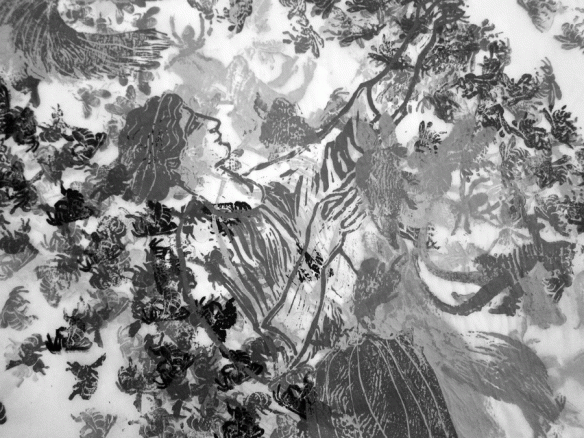This summer has been a busy one–completing the large bee project, (I feel like I should say this in capital letters and with arms waving); I have the great privilege of being part of an exhibition at the Richmond Art Gallery next month. So there are many things I have neglected in order to focus completely on preparations for this upcoming show.
But I’ve also been peering very closely at little blurs of bees in my immediate neighborhood. This project is with the Environmental Youth Alliance and the Citizen Science Bee Survey (which has been a fantastic experience). I’m learning more and more about our native bee species every day, and loving every minute of it. This project too, is soon coming to an end.
And I’ve been invading the private parts of wonderous flowers, anxiously looking for that lovely dust, pollen; and seeking out nectar-and-pollen rich bee plants with my friend and bee-master, Lori Weidenhammer. (And now that the flowering season is winding down, I realize just how little pollen I’ve managed to collect–ha, the work will have to wait for next spring). I’d make a shameful bee.
I know that many artists are able to reflect upon their work while in the process of working, (some are highly articulate) and yes, I have scribbled notes and scratched drawings in sketchbooks and in various other places, but to stop, to step back, and to consider what this bee project has really been for me these past 3 years is another matter altogether. It requires a sense of detachment which I do not have at the moment. Perhaps I will start with this then, the crux of the matter–that art is not detached–not from life, not from our relationships, not from our modes of being, of thinking and of doing.I am like the Harvester in the image above (detail from my bee project, not by chance alone). In the midst of activity, every encounter, (tiny or substantial) brushes against me, and I with it; and it leaves its mark.This is existence, this is art for me, not autonomous, but deeply relational (even though I do so much of my work alone). I recall Cheryl Meszaros, a beloved teacher and mentor, defining the work of the artist– she said the artist pulls, withdraws something from the social imaginary, transforms it, allows us to see it in a new way, and then puts it back into that imaginary. Each perspective adding to the ones already there. Cheryl was doubtless quoting the work of a philosopher, for she loved philosophy. My encounters with Cheryl are endless, despite her passing; her work has affected me deeply.

